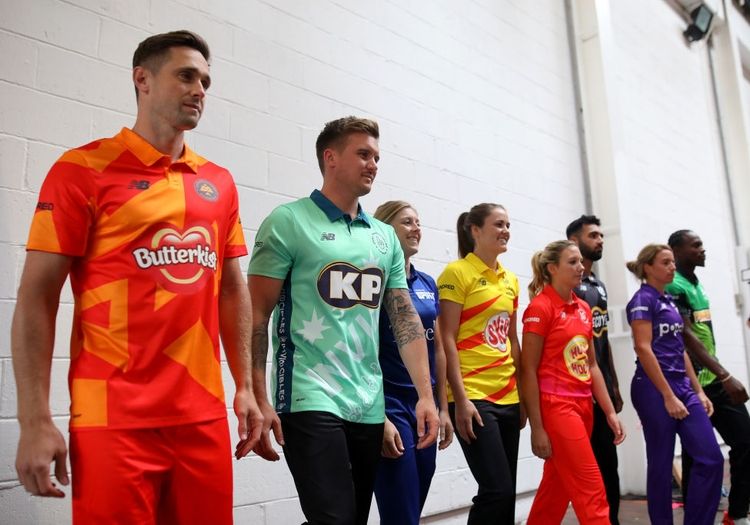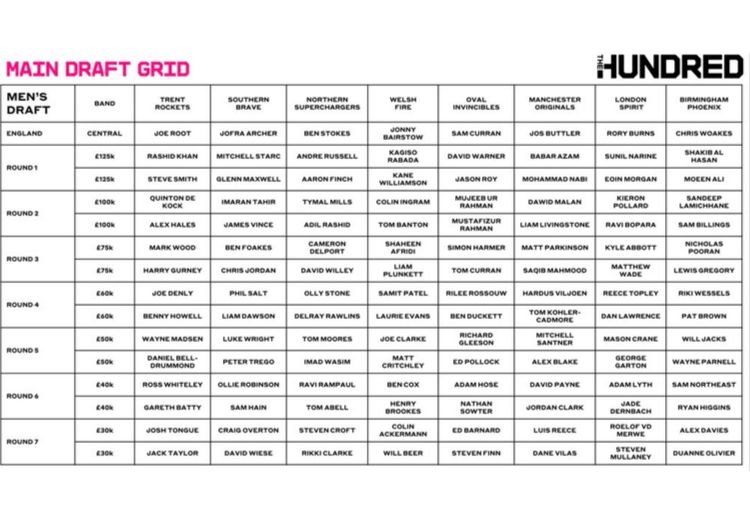The Cricketer was invited on Wednesday to a mock draft for The Hundred ahead of Sunday's real thing. NICK FRIEND and HUW TURBERVILL, in charge of Manchester Originals for the day, went along to see quite how this will work


On Sunday, eight of the world’s top coaches will huddle up at eight desks at Sky HQ, armed with a spreadsheet and twelve empty spaces to fill. One will be a World Cup winner. Another, arguably, is the finest cricketer to ever have played the game. Seven have experience of leading an Indian Premier League franchise.
On Wednesday, eight sets of cricket journalists were called upon to test the system, to put something tangible to a much-maligned concept, to pick a squad worthy of all that The Hundred needs to achieve.
The criticism thus far has been wide-ranging, much of it – at the very least – understandable: what it means for the future of the county game; how this new set of teams can peacefully coexist with 18 clubs full of history and tradition; what effect this has on the Vitality Blast, a competition at the height of its popularity; where it all leaves county members; how it will lead to improvements at grassroots level – as, it is claimed, it will do.
Drafts are not easy to master; they can be fiddly, cumbersome, painstaking – all the things that The Hundred says it isn’t and can’t afford to be. I attended the Caribbean Premier League draft in May – a competition now seven years old.
It was at times chaotic, held together only by the enduring quality of Mel Jones, the broadcast’s anchor. One member of the audience told me during a moment of confusion: “The CPL has six years of goodwill behind it. The Hundred doesn’t.”
Essentially, the CPL has built up a brand and, as a result, can get away with those moments. As a general rule, however, there is no margin for error – not in live television, and certainly not when you are attempting to fight back against considerable scepticism.
And this is why we are here, crammed into a Tavern Stand suite that overlooks the Lord’s turf. It is a consequence of major redevelopment works to the Compton and Edrich Stands. For the moment, both have been consigned to rubble – to be replaced by something bigger, grander, with views less obtrusive for those at the back of the lower tier.
The laptops we are using and the online system – an app developed over the course of a year and designed to make the whole process as easy as possible – are the very same as those the head coaches will use come Sunday. It certainly seems foolproof.
The Cricketer have been allocated Manchester Originals. In many ways, the Emirates Old Trafford franchise – clad in McCoys charcoal – are the most intriguing of the eight; the only single-county outfit. Daniel Gidney, Lancashire’s chief executive, believes that is in itself a disadvantage. Both Glen Chapple and Mark Chilton will work alongside head coach Simon Katich in Manchester’s backroom team, leaving a hole in Lancashire’s resources.
In our ‘mock’ squad, we have ended up with Matt Parkinson, Saqib Mahmood, Jos Buttler, Liam Livingstone and Dane Vilas – a quintet of Lancashire players. Not all were by design, but it raises a quandary nonetheless. Where does this leave Lancashire? We will find out come Sunday, but it is a fair concern among county fans. Overall in the mock draft, eight Lancashire players were picked up (Manchester’s five plus Richard Gleeson, Alex Davies and Steven Croft elsewhere), while nine went from Worcestershire.
The early selections announced at the team reveal two weeks ago have landed ‘us’ with Jos Buttler, as expected, along with Matt Parkinson and Saqib Mahmood, both of whom have been called up by England for the tour of New Zealand. They have both been written in at £75,000 each, taking up Manchester’s third-round picks in the draft, but opening up the first two price brackets, with two players per category. No other team has that luxury.

In hindsight, we might have used that unique opportunity better than we did. Both Huw and I are keen fantasy sport players, though neither all that successful. Essentially, this is the same game – can you spot the bargain that nobody else can see? What do the numbers say? How left-field is too far left-field? Is there a reason everyone else has steered well clear?
Manchester will make the sixth pick in Sunday’s draft. And so, after Wisden’s Taha Hashim and Ben Gardner opt to pair David Warner with Jason Roy at the top of the Oval Invincibles lineup, we plump for Babar Azam. It is a bold – if cavalier – move on a number of levels. On the assumption that he is part of Pakistan’s Test squad to face England, he will be available for just three games.
However, as per the competition’s rules, Manchester would then be able to pick a replacement in the same price band, potentially Chris Gayle or Lasith Malinga, both of whom went unpicked by our motley crew of journalist-selectors. Three games of Azam followed by five of Gayle? Not the worst compromise position.
If, as in all likelihood, Azam was to become unavailable, he would be paid on a pro-rata basis according to the amount of games he plays. If he were to feature in just the first three matches, therefore, having been selected in the £125,000 bracket, he would be entitled to three eighths of that figure, with the same pro rata structure in place for his replacement.
We followed the Pakistan star with Mohammad Nabi, the Afghan allrounder. Like Azam, Nabi had set a reserve price of £75,000 – well below the £125,000 fee we were prepared to fork out for his signature.
To clarify, the reserve prices exist for the same purpose as they might do in an auction – in essence, you are prepared to be sold, but not for a lower price than whatever you set as your base value. Thus, Gayle and Malinga, who set a £125,000 reserve on their names, were no longer available to be signed up once the first round – the £125,000 bracket – had been completed.
Nabi, on reflection, was a premature move – not so much in his selection, but in the timing of it; an ideal third overseas pick, but an unnecessary use of a second choice. We missed out on Kane Williamson, Aaron Finch, Glenn Maxwell and Steve Smith in committing to Nabi’s combination of wily off-breaks and explosive hitting. The end of the world, though? Absolutely not.
As the draft went on, however, any early regret began to diminish. We had, at the very least, defined our strategy from the outset. Dawid Malan, Tom Kohler-Cadmore and Alex Blake joined to form a hard-hitting trio, while Hardus Viljoen added a much-needed secondary pace option and David Payne the golden left-arm angle. His recent white-ball record makes him a very plausible left-field pick come Sunday.
A slow-bowling stable already containing Parkinson and Nabi was joined by New Zealand’s Mitchell Santner, as well as the more part-time option of Liam Livingstone’s mixture of off-breaks and leg-spinners.
Santner, by the way, whose economy rate in T20 cricket lies below seven; one follower on Twitter described his selection as one of the standout picks of the draft, albeit on an ultimately meaningless day!

Nick Friend's pre-Draft notes (after the draft), while Chris Gayle went unsold in the mock draft
The tactic, therefore, would be straightforward at a ground with distant square boundaries and a pitch suited to spin.
Other players of similar skillsets came and went. Never have I taken part in anything where even the best-laid plans were so ruthlessly destroyed before your eyes.
Nathan Sowter, Shakib Al Hasan, Ravi Bopara, Will Jacks, Imran Tahir and Sandeep Lamichhane were all – at one point or another – next on our list. On each occasion, they were picked up by those around us – either by Adam Collins and Vithushan Ehantharajah’s Trent Rockets, Simon Wilde and Lizzy Ammon’s London Spirit or Birmingham Phoenix, overseen by the incomparable pair of Henry Moeran and Dan Norcross.
In truth, it is a game of frustration – of who gets the most frustrated, of who hides it best and whose pent-up anger manifests itself in panic-buys.
One theory to emerge from some in the room was the idea that the 100-ball format would reduce opportunities for bits-and-pieces cricketers and heighten the importance of specialists – in essence, that the team could almost be split in two between six batsmen and five bowlers.
By the time we had finally finished putting together these entirely fictional teams, our 15-man squad possessed nine genuine bowling options – ten, if you include the leg-spin of Malan, along with a further ten players who would deem themselves to be top-six batsmen.
Perhaps, compared to the other seven sides in the room, ours became a lower-profile list than those around it – an intriguing team of which I grew fonder, the more I stared down at it. Of course, it means nothing. The real business takes place on Sunday evening in what will represent the first draft in the history of English cricket.
And while that, in itself, is nothing to shout about from the rooftops, it does mean that the game in this country and those who follow it will be introduced to a fascinating concept.
In an attempt to prepare for the afternoon, I had drawn up a 57-man shortlist of potential recruits, each split up into categories, and then each given a number against their name, which represented my preference within each subsection (batsman, allrounder, seamer, spinner, wicketkeeper).
Where possible, we never once deviated from our pre-draft list. Yet, of the twelve players we ultimately selected, only six had featured in my initial workings at all. Of those six, only Malan and Viljoen were first-choice in their subsection. Simply, all others were snatched away from our greatest intentions – see above for my scrawled masterplan.
What is clear is that 100 seconds is a long time. Our 57-strong document would be a mere footnote in the hands of the hordes of analysts assisting each team on Sunday. From that perspective, at least, there should be few problems.
I say this with only the flimsiest modicum of first-hand experience, but it is harder than it looks. One futile attempt to pick up Scotland’s George Munsey, who was not on the system, caused what Cricinfo’s Matt Roller described as “draft-room drama”.
There was, at one stage, an hourlong enforced break due to technical difficulties. That, of course, is the real reason for holding such a session – to iron out any final issues. Ian Ward and Isa Guha are in charge of leading the coverage on the night, with any delays – foreseen or otherwise – to be smoothed over by a shortening of analysis periods.
With a three-hour television window, a smooth run is a matter of urgency. And frankly, given the feeling towards the competition in many quarters, it can ill-afford a false start with a botched draft.
The Cricketer’s squad:
Babar Azam
Mohammad Nabi
Dawid Malan
Liam Livingstone
Matt Parkinson
Saqib Mahmood
Hardus Viljoen
Tom Kohler-Cadmore
Mitch Santner
Alex Blake
David Payne
Jordan Clark
Luis Reece
Dane Vilas
The Cricketer’s XI:
Babar Azam
Jos Buttler
Tom Kohler-Cadmore
Dawid Malan
Liam Livingstone
Mohammad Nabi
Dane Vilas (c, wk)
Mitch Santner
Hardus Viljoen
Saqib Mahmood
Matt Parkinson
Alex Blake
David Payne
Luis Reece
Jordan Clark
Subscribe to The Cricketer for exclusive content every day: The inside track on England's Test tour with George Dobell in Pakistan, award-winning analysis, breaking news and interviews and the only place for in-depth county coverage all year round. Plus: An ad-free app experience at your fingertips. Subscribe to thecricketer.com today for just £1.